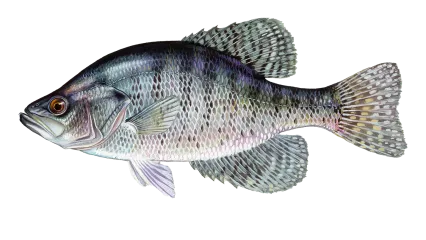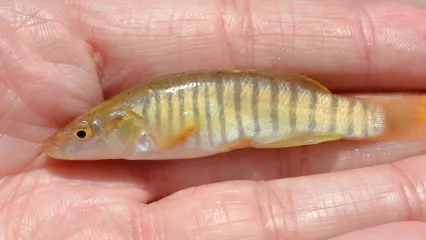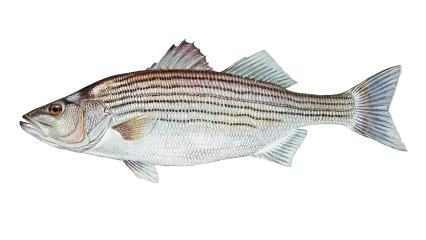
Description
When fishing in an eastern Oklahoma river, you might be shocked if you reel in one of these - but there's no need to be alarmed! It is not a snake nor an electric eel, but rather it's the harmless American eel. In fact, unlike the electric eel (which is not an "eel" but actually a species of knifefish), the American eel is a true eel of the order Anguilliformes and quite harmless despite its snakelike appearance.
This fish may seem alien to most Oklahomans because it is an uncommon catch for fisherman and because they are not present in large numbers in this region. The few eels that inhabit Oklahoma's rivers are natural treasures, especially when one considers the arduous journey and obstacles they must overcome to make it to the Sooner State.
The American eel plays an important role in local and oceanic ecosystems as prey for many mammals, birds and predatory fish. Additionally, American eels act as a host for freshwater mussels that are important for managing the water quality of Oklahoma's streams. Although these factors have contributed to a decline in American eel stocks over the past few decades, the implementation of responsible conservation strategies and commercial fishing quotas have prevented the need to put the American eel under the protections of the Endangered Species Act. Oklahoma's wildlife is diverse and abundant. And the American eel's presence adds another interesting element to our local ecosystem while connecting to an even larger ecosystem thousands of miles away: the ocean.
Size
Lengths of 3 to 5 feet.
Habitat
American eels are naturally expert travelers; as catadromous fish, they migrate from their birthplace in the Sargasso Sea in the Atlantic Ocean up through coastal inlets and deep into inland freshwater rivers where they live before returning to sea to spawn.
Reaching their native range has proved increasingly difficult in the modern age, as dams affect migration routes and global demand for eels as a food source spikes. With bodies capable of absorbing oxygen, some eels are able to bypass small obstructions by slithering on land through grass or mud.
Life Cycle
Upon returning to their spawning waters, the adult females dispense their eggs freely in the water to float on the surface before they hatch. From the larval stage, they grow into the juvenile stage, in which they're called glass eels (due to their translucent properties.) They start their long journey towards the coast. Once in the marine estuary where saltwater turns fresh, the glass eels take on an opaquely gray color in the elver stage and begin their journey up freshwater streams.
With a vast native range from eastern Canada down to Mexico, the adolescent elvers instinctively head toward the coastal inlets. But it's just a matter of chance that dictates what freshwater river that individual eel will end up in. Will it be the Penobscot River in Maine, or 2,000 miles away in the Kiamichi River in southeastern Oklahoma? Swimming thousands of miles through open ocean and freshwater rivers sounds long and exhausting. But with streamlined bodies and efficient use of ocean currents, the young eels make the trip in about 200 days.
In the upper stretches of tributaries, the eels transform again, this time into a sexually immature adult phase known as yellow eel. Once far enough upstream, their migratory instincts relax, and the yellow eels settle for long-term residency in the river. Some eels will live there for 15 to 20 years. With plenty of time until their reproductive maturity arrives, the yellow eels burrow deep in the river's mud bottom during the day and feed actively at night. When full sexual maturity arrives, the eel is then called a silver eel, and it transforms its fin and body to better adapt to the long journey back to its spawning waters. Upon returning to its birthplace, the eel releases its eggs and quickly dies.


